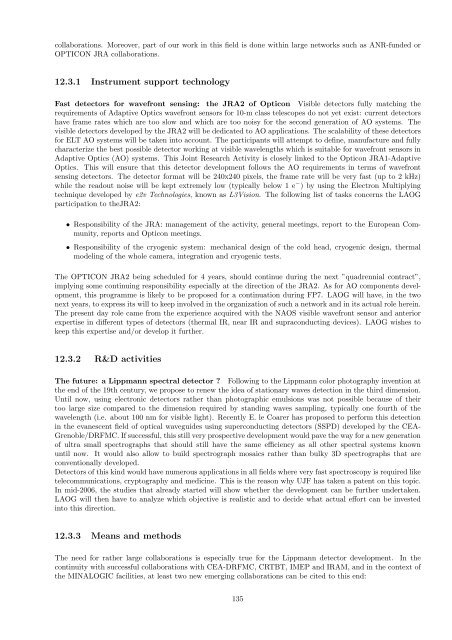Untitled - Laboratoire d'Astrophysique de l'Observatoire de Grenoble
Untitled - Laboratoire d'Astrophysique de l'Observatoire de Grenoble
Untitled - Laboratoire d'Astrophysique de l'Observatoire de Grenoble
You also want an ePaper? Increase the reach of your titles
YUMPU automatically turns print PDFs into web optimized ePapers that Google loves.
collaborations. Moreover, part of our work in this field is done within large networks such as ANR-fun<strong>de</strong>d or<br />
OPTICON JRA collaborations.<br />
12.3.1 Instrument support technology<br />
Fast <strong>de</strong>tectors for wavefront sensing: the JRA2 of Opticon Visible <strong>de</strong>tectors fully matching the<br />
requirements of Adaptive Optics wavefront sensors for 10-m class telescopes do not yet exist: current <strong>de</strong>tectors<br />
have frame rates which are too slow and which are too noisy for the second generation of AO systems. The<br />
visible <strong>de</strong>tectors <strong>de</strong>veloped by the JRA2 will be <strong>de</strong>dicated to AO applications. The scalability of these <strong>de</strong>tectors<br />
for ELT AO systems will be taken into account. The participants will attempt to <strong>de</strong>fine, manufacture and fully<br />
characterize the best possible <strong>de</strong>tector working at visible wavelengths which is suitable for wavefront sensors in<br />
Adaptive Optics (AO) systems. This Joint Research Activity is closely linked to the Opticon JRA1-Adaptive<br />
Optics. This will ensure that this <strong>de</strong>tector <strong>de</strong>velopment follows the AO requirements in terms of wavefront<br />
sensing <strong>de</strong>tectors. The <strong>de</strong>tector format will be 240x240 pixels, the frame rate will be very fast (up to 2 kHz)<br />
while the readout noise will be kept extremely low (typically below 1 e − ) by using the Electron Multiplying<br />
technique <strong>de</strong>veloped by e2v Technologies, known as L3Vision. The following list of tasks concerns the LAOG<br />
participation to theJRA2:<br />
• Responsibility of the JRA: management of the activity, general meetings, report to the European Community,<br />
reports and Opticon meetings.<br />
• Responsibility of the cryogenic system: mechanical <strong>de</strong>sign of the cold head, cryogenic <strong>de</strong>sign, thermal<br />
mo<strong>de</strong>ling of the whole camera, integration and cryogenic tests.<br />
The OPTICON JRA2 being scheduled for 4 years, should continue during the next ”quadrennial contract”,<br />
implying some continuing responsibility especially at the direction of the JRA2. As for AO components <strong>de</strong>velopment,<br />
this programme is likely to be proposed for a continuation during FP7. LAOG will have, in the two<br />
next years, to express its will to keep involved in the organization of such a network and in its actual role herein.<br />
The present day role came from the experience acquired with the NAOS visible wavefront sensor and anterior<br />
expertise in different types of <strong>de</strong>tectors (thermal IR, near IR and supraconducting <strong>de</strong>vices). LAOG wishes to<br />
keep this expertise and/or <strong>de</strong>velop it further.<br />
12.3.2 R&D activities<br />
The future: a Lippmann spectral <strong>de</strong>tector ? Following to the Lippmann color photography invention at<br />
the end of the 19th century, we propose to renew the i<strong>de</strong>a of stationary waves <strong>de</strong>tection in the third dimension.<br />
Until now, using electronic <strong>de</strong>tectors rather than photographic emulsions was not possible because of their<br />
too large size compared to the dimension required by standing waves sampling, typically one fourth of the<br />
wavelength (i.e. about 100 nm for visible light). Recently E. le Coarer has proposed to perform this <strong>de</strong>tection<br />
in the evanescent field of optical wavegui<strong>de</strong>s using superconducting <strong>de</strong>tectors (SSPD) <strong>de</strong>veloped by the CEA-<br />
<strong>Grenoble</strong>/DRFMC. If successful, this still very prospective <strong>de</strong>velopment would pave the way for a new generation<br />
of ultra small spectrographs that should still have the same efficiency as all other spectral systems known<br />
until now. It would also allow to build spectrograph mosaics rather than bulky 3D spectrographs that are<br />
conventionally <strong>de</strong>veloped.<br />
Detectors of this kind would have numerous applications in all fields where very fast spectroscopy is required like<br />
telecommunications, cryptography and medicine. This is the reason why UJF has taken a patent on this topic.<br />
In mid-2006, the studies that already started will show whether the <strong>de</strong>velopment can be further un<strong>de</strong>rtaken.<br />
LAOG will then have to analyze which objective is realistic and to <strong>de</strong>ci<strong>de</strong> what actual effort can be invested<br />
into this direction.<br />
12.3.3 Means and methods<br />
The need for rather large collaborations is especially true for the Lippmann <strong>de</strong>tector <strong>de</strong>velopment. In the<br />
continuity with successful collaborations with CEA-DRFMC, CRTBT, IMEP and IRAM, and in the context of<br />
the MINALOGIC facilities, at least two new emerging collaborations can be cited to this end:<br />
135




